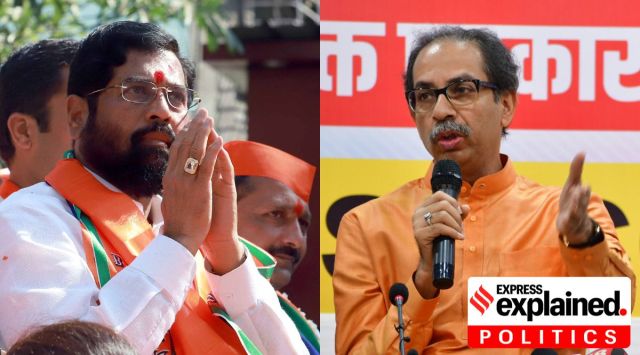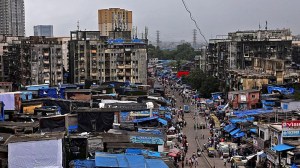Supreme Court verdict on Maharashtra: What was the 2022 political crisis in the state?
Rival groups of Shiv Sena – the Eknath Shinde group and the Uddhav Thackeray group – petitioned the SC last year in relation to the political crisis in the state. Here is a recap of the allegations of horse trading, alliances, resort politics and more.
 Maharashtra Chief minister Eknath Shinde (left) and Shivsena (Uddhav Balasaheb Thackeray) party Chief Uddhav Thackeray (right). (Express file photos by Pavan Khengre, left, and Ganesh Shirsekar, right)
Maharashtra Chief minister Eknath Shinde (left) and Shivsena (Uddhav Balasaheb Thackeray) party Chief Uddhav Thackeray (right). (Express file photos by Pavan Khengre, left, and Ganesh Shirsekar, right) The Supreme Court will soon give its verdict today on the political turmoil triggered in Maharashtra last year in June that led to then Chief Minister and Shiv Sena leader Uddhav Thackeray stepping down from his post, after his party’s MLA Eknath Shinde broke away to assert his own faction’s supremacy. Shinde then became the CM in July 2022 with the BJP’s support.
The list of business for the day in the Supreme Court showed a unanimous verdict from the five-judge Constitution bench that is headed by Chief Justice of India (CJI) DY and includes Justices MR Shah, Krishna Murari, Hima Kohli and PS Narasimha.
What was the Shiv Sena case?
Rival groups of Shiv Sena – the Eknath Shinde group and the Uddhav Thackeray group – petitioned the SC last year in relation to the political crisis in the state.
In August 2022, a three-judge bench of the top court referred to a five-judge Constitution bench on the issues involved, saying some of the questions raised as part of it may require a larger Constitution bench for consideration.
The Shinde group’s plea also challenged the disqualification notices served on him and 15 MLAs supporting him.
What was the political setup in Maharashtra before the crisis?
On June 21, 2022, after it was suspected that MLAs took part in cross-voting during the Legislative Council elections, then CM Thackeray called for an urgent meeting of Shiv Sena MLAs.
At this point, he headed the Maharashtra government as part of the Maharashtra Vikas Aghadi (MVA), a three-party alliance consisting of the Shiv Sena, the Congress and the Nationalist Congress Party (NCP) led by Sharad Pawar.
Formed after the 2019 state elections, the MVA was a result of the Shiv Sena’s differences with its pre-poll alliance partner, the BJP. The two had earlier headed the state government, from 2014 to 2019. Allegedly, issues over power sharing led to the rift between the parties, and Sena then joined the MVA.
These various alliances were preceded by a hung Assembly in the 2019 elections. The BJP emerged as the party with the most seats (105), but it fell short of the majority mark of 145 in the 288-seat Assembly. Shiv Sena (56) and the NCP (54) followed in terms of seats’ share. Along with the Congress and support from some other parties, a government was formed.
Why was there a political crisis in Maharashtra in 2022?
In 2022, after suspicions of cross-voting, the Shiv Sena meeting on June 25 did not see the presence of leader Eknath Shinde and 11 MLAs. What followed was a week of ‘resort politics’, with the missing Sena leaders found camping in luxury hotels in Surat and Guwahati. That they were in BJP-ruled states led to allegations of horse trading from the MVA that were denied by the BJP.
Then Maharashtra Deputy Speaker Narhari Zirwal issued notice on pleas seeking the disqualification of these MPs from the Assembly. The rebels approached the top court against the disqualification proceedings, where a three-judge bench granted an extension of time to the rebels to respond to the notices.
What has happened in the Supreme Court so far?
Since then, the court has been hearing a batch of petitions filed by both groups from the Shiv Sena. The Shinde camp leaders first challenged the June 21 decision of Zirwal, recognising Ajay Choudhari as leader of the Shiv Sena Legislature Party (SSLP) in place of Shinde, calling it “illegal, unconstitutional” and taken with “bias”.
They said Zirwal had taken the decision because his party, the NCP, was supporting the “minority faction” of the Sena led by Thackeray. The plea also challenged the disqualification notices served on Shinde and 15 MLAs supporting him on June 25 for not attending the party meeting convened by then Chief Minister Thackeray.
The Thackeray faction, in turn, pleaded before the apex court for setting aside then Maharashtra Governor BS Koshyari’s June 2022 order to then CM Uddhav Thackeray to take a floor test, asserting democracy will be in danger if it is not overturned. On June 29, 2022, the top court gave a go-ahead to the floor test in the Maharashtra Assembly a day later.
The SC’s refusal meant that Thackeray had to prove his majority support on the floor of the House on the given date. After the court’s order, he announced his resignation as the Chief Minister and Eknath Shinde was later sworn in as the Chief Minister, with BJP’s Devendra Fadnavis as his deputy CM.
In February 2023, the Election Commission of India ruled that the Shinde faction had the right to use the name ‘Shiv Sena’ and the election symbol ‘Bow and Arrow’ that is reserved for the party under The Symbols (Reservation and Allotment) Order, 1968.
The five-judge constitution bench of the Supreme Court concluded the hearing on the pleas on March 16 and reserved its verdict. At the time, it asked how Uddhav Thackeray could be reinstated as CM, even if it finds the Governor’s action in calling for a trust vote illegal, given that he had resigned without facing the floor test, “accepting” that he was in a minority.


- 01
- 02
- 03
- 04
- 05



































